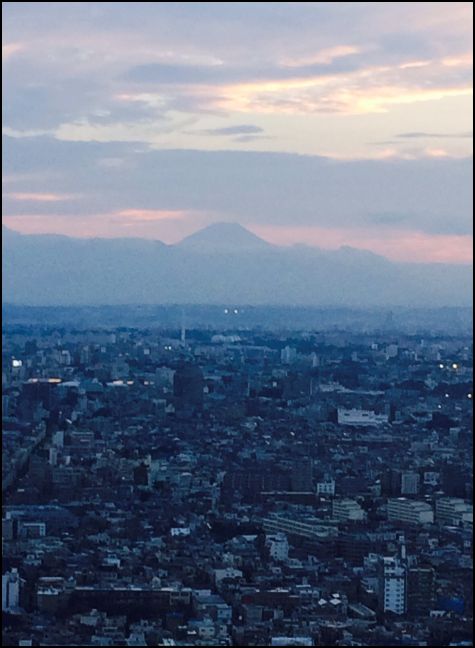What for dinner in Tokyo? How about 14 courses, small but delicious?


By Eileen Ogintz
TOKYO, Japan — How many courses?
If you opt for the traditional Japanese Kaiseki cuisine that dates back 500 years, you will be served as many as 14 small courses artfully prepared and exquisitely presented. The term also notes the skills and techniques necessary to prepare such meals. The French, in fact, were inspired by this cuisine in the early years of the 20th Century. Geishas entertained at such dinners for their clients.
If you think that might be a little much to handle, come sample Chef Kenichiro Ooe’s fare at Kozue on the 40th floor of the Park Hyatt Tokyo with stellar views of the city.
He serves eight slightly larger courses, plus a small desert. Rice or noodles is served at the end of the meal, he explained. We had:
— A cold appetizer (simmered crab in a ginger vinaigrette with soybeans and ginko nuts)
— A warm appetizer (simmered deep fried eel, with grated radish and seasonal vegetables)
— Soup (soft-shell turtle dumpling)
— Sashimi
— Delicacies (Pike eel sushi, sweet corn tempura… candied goby fish… crushed yam and more)
–Grilled fish (eel with Japanese pepper and sesame)
–Chef’s Recommendation (simmered abalone, sea urchin, leeks and greens)
–Shokuji (rice, deep fried fish or soba noodles with sea bream tempura)
–Desert (tomato sherbet)

If you think it sounds like a lot of food, it really wasn’t and it is served on beautiful pieces of Japanese pottery and laquerware to match the dishes. The menu changes seasonally. “I want foreign guests to enjoy the experience—the way the foods are selected and prepared and presented a certain way. This represents Japanese cuisine,” Chef Ooe said.
Chef Ooe wants people to relax and enjoy the experience, thus fewer courses. He explains that too often, people don’t know what they are eating and the courses go on so long that they become tense. (My husband did at one very long such dinner.)
The presentation and the dishes served, he said, should be “visually stimulating and a conversation piece.” Most important, guests should be relaxed and enjoy the experience. Kids are welcome, he said, and if his staff is advised in advance, they can present fewer courses but in a way that will introduce diners to this traditional Japanese cuisine. “Savor each course,” he urges. With sake of course.

Interestingly, 70 per cent of the guests at the 177-room hotel are westerners while only 30 per cent of the restaurant guests are. Many Japanese are fans of the hotel’s New York Grill with its open kitchen, 1,800-bottle wine cellar and the place to sample Japan’s famous beef, said Chef Federico Heinzmann, who is from Argentina. “Japanese food is very complex,” he said. “The idea of the New York Grill is more relaxed but the place to see why there is so much fuss about Japanese beef and tuna.”
Tokyo, he said, is a mecca for foodies—starting for kids just exploring new cuisine. (Rice Balls can’t miss—kind of a triangle with different fillings surrounded by rice.) He notes that Japanese cattle farms are small—anywhere from 20-300 cows and thus the emphasis on quality. Depending on where the farm is located, that will influence the taste of the beef. Absolutely the focus is on quality.
That could be said of this hotel on the top floors of a skyscraper in the world’s second largest city in West Shinjuku with its nearby park and performing arts complex. The hotel was designed by Dr. Kenzo Tange, the father of modern Japanese architecture, who established his career providing the plans for the rebuilding of Hiroshima. Nearly every public space and room offers spectacular views and the building boasts earthquake stabilizers.

The fitness center and spa is so spectacular that locals spend upwards of $50,000 to join it as a private club. The 65-foot pool boasts a glass roof.
There are many families here as every guest is made to feel welcome, no matter their age or where they are from. Apparently, the signage was made especially subtle to keep the staff on their toes—paying attention to guests who might not be able to find an elevator or a bathroom. The staff is very attentive, which families love.
Kids would love a scavenger hunt based on the hotel’s art—really. Consider that “Gutsy” graces the hotel’s front entrance—an enormous hand made mask crafted by Japanese artist Mieko Yuki, greeting guests with a funny smile. There are whimsical ceramic muses and jesters in the Delicatessen, the hotel’s most casual eatery, and in the main elevator.
I especially liked “Airflow,” by Sculptor Antony Donaldson—the bronze and steel “globe” conveys the international theme of the hotel of going to another universe—and leaving time at the door (there is a watch to symbolize that.)
That’s the way travel should be!
